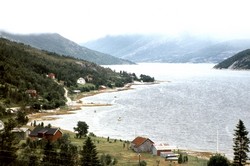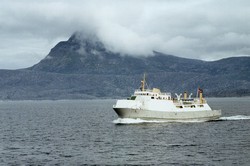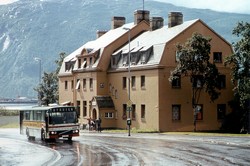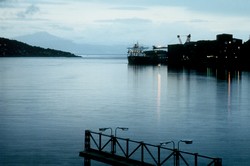Aboard of ferry boats
A highway at sea
 The period of good weather ends. Dark clouds accompany me for the next days.
I stop at the less interesting village of Fauske after 65 km because of
rain. The road leads through two tunnels of which the longest one is 1,7 km,
however well illuminated.
The period of good weather ends. Dark clouds accompany me for the next days.
I stop at the less interesting village of Fauske after 65 km because of
rain. The road leads through two tunnels of which the longest one is 1,7 km,
however well illuminated.
 Next day I start early in the morning. The road follows the coast line except for
those peninsulas that are crossed directly and steeply. To make 100 km a
day I have to work hard. And so I have to overcome many hundred meters of altitude.
Next day I start early in the morning. The road follows the coast line except for
those peninsulas that are crossed directly and steeply. To make 100 km a
day I have to work hard. And so I have to overcome many hundred meters of altitude.
 Scenery, however, is really great. The mountains stand out of the waters upto
1000 m. The european highway no. 6 quits the land to be continued by
ferry boats. While car tourists have to wait upto one hour to get across, I overtake
them and get on board without delay. Today there is only one ferry left while the
other was replaced by a new routeing of the road, including new toll bridges and tunnels.
Scenery, however, is really great. The mountains stand out of the waters upto
1000 m. The european highway no. 6 quits the land to be continued by
ferry boats. While car tourists have to wait upto one hour to get across, I overtake
them and get on board without delay. Today there is only one ferry left while the
other was replaced by a new routeing of the road, including new toll bridges and tunnels.
 The weather becomes very special. It is very cloudy but dry on the shore and
starts raining as soon as I start climbing the hills. But there is one advantage
about them - in the lee I don't suffer any more from the steady head winds. In the
evening I usually camp on a meadow on the shore. In the morning I often wake up
with a view scenic like that on the photo taken near Narvik.
The weather becomes very special. It is very cloudy but dry on the shore and
starts raining as soon as I start climbing the hills. But there is one advantage
about them - in the lee I don't suffer any more from the steady head winds. In the
evening I usually camp on a meadow on the shore. In the morning I often wake up
with a view scenic like that on the photo taken near Narvik.
 From now on I call the trip a «way of pain». There are many hills to climb and
nearly every evening I have to fix and replace a broken link of the chain.
It is somewhat anoying to stop the bike, steer it into the roadside ditch
and mend the chain with damp fingers while being exhausted from a long day's
cycling.
From now on I call the trip a «way of pain». There are many hills to climb and
nearly every evening I have to fix and replace a broken link of the chain.
It is somewhat anoying to stop the bike, steer it into the roadside ditch
and mend the chain with damp fingers while being exhausted from a long day's
cycling.
 In the end, however, I succeed in reaching Narvik where I decide to buy
some more chain links. I remember the words of a friend of mine: «Bikes don't die
that fast».
In the end, however, I succeed in reaching Narvik where I decide to buy
some more chain links. I remember the words of a friend of mine: «Bikes don't die
that fast».
 I get to Narvik in the early morning of a sunday. So I have to wait a day
to buy some equipement for the bike. The day is sunny and warm and I take
a day off, now that more than 2500 km are done. At midnight I have a
wonderful view at the harbour from the window of the former local youth
hostel. Most of the ships load iron-ore from Kiruna, Sweden.
I get to Narvik in the early morning of a sunday. So I have to wait a day
to buy some equipement for the bike. The day is sunny and warm and I take
a day off, now that more than 2500 km are done. At midnight I have a
wonderful view at the harbour from the window of the former local youth
hostel. Most of the ships load iron-ore from Kiruna, Sweden.